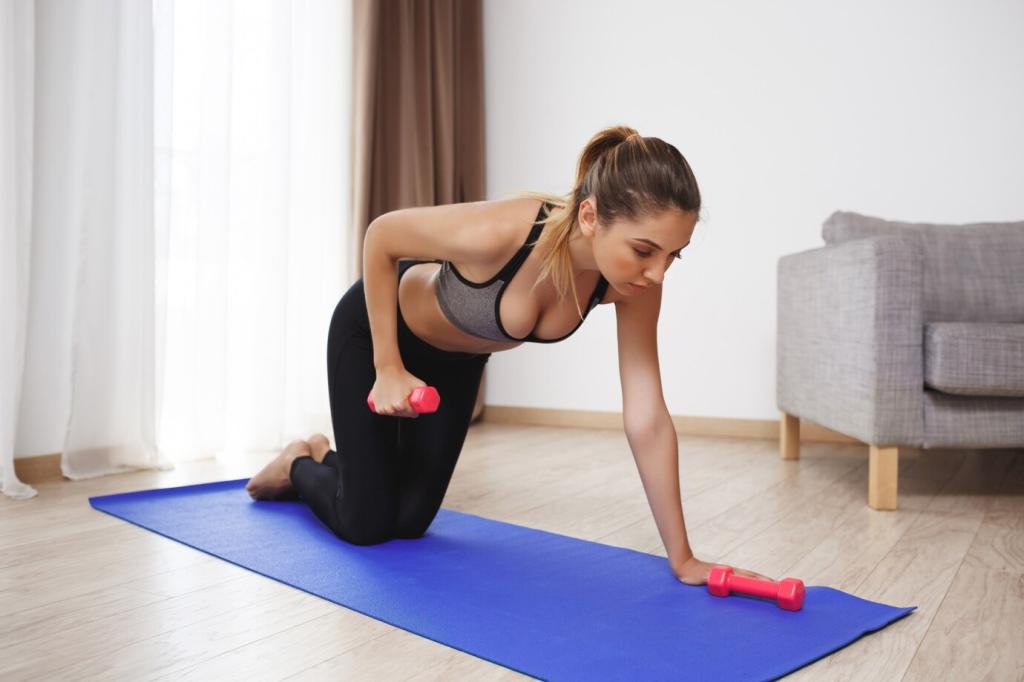
Build Your Rhythm: Creating a Balanced Home Workout Schedule
Chosen theme: Creating a Balanced Home Workout Schedule. Welcome to your blueprint for sustainable, energizing fitness at home—where consistency beats intensity and small, smart choices compound into lasting strength. Read on, then share your weekly plan or subscribe for fresh schedule ideas and accountability nudges.
Why Balance Beats Burnout
01
Most progress comes from consistent, moderate effort anchored by recovery. Short, well-planned sessions aligned with your energy peaks outperform sporadic marathons. Mix stress and rest deliberately so your body adapts rather than rebels.
02
I used to miss every Tuesday workout because late Zoom calls drained me. Shifting Tuesday to mobility and a brisk walk changed everything. Momentum returned, soreness eased, and I finally strung together a month of uninterrupted training.
03
Increasing volume by roughly ten percent weekly is a safe guideline. Alternate hard and easy days, and let one full recovery day reset your nervous system. Balance makes intensity possible, and progress sustainable.
Designing Your Weekly Template
Aim for two to three strength days, two cardio-focused sessions, and one longer mobility block. This blend builds muscle, supports heart health, and keeps joints happy. Your schedule becomes resilient, not fragile.
Reserve thirty to forty minutes per session on your calendar like any meeting. Add five-minute buffers for warm-ups and cool-downs. Set a phone reminder and lay out equipment beforehand to reduce friction when it is go time.
Attach workouts to a reliable daily cue like post-coffee or after putting the kids to bed. Habit stacking reduces decision fatigue. When life gets messy, the cue still shows up and carries your routine forward.

Equipment-Light, Results-Heavy
Prioritize push-ups, squats, lunges, hip hinges, and planks. Modify angles, tempos, and ranges to progress without equipment. Rate effort on a one-to-ten scale and stop with two reps in reserve to protect form and joints.
Equipment-Light, Results-Heavy
Create tiny workout zones: a yoga mat by the window, a resistance band on a door hook, and a sturdy chair for step-ups. Visual cues reduce setup time and make exercise the path of least resistance.
Recovery You Can Feel Good About
Sleep is Your Silent Spotter
Seven to nine hours unlocks strength gains and appetite control. Keep wake time consistent, dim screens at night, and cool the room slightly. Your schedule should protect sleep the way you protect a favorite lift.
Five-Minute Mobility Sandwich
Before strength, use dynamic moves like leg swings and arm circles. Afterward, breathe slowly and stretch calves, hips, and thoracic spine. This sandwich fights stiffness and keeps tomorrow’s workout feeling inviting instead of intimidating.
Active Recovery Rituals
On light days, walk ten thousand steps, foam roll calves and quads, and sip water through the afternoon. Share your favorite recovery ritual in the comments, and subscribe for our monthly recovery checklist.
The Two-Column Log
Write what you planned in one column and what you actually did in the other. Add a quick mood note and sleep rating. This honest snapshot highlights wins, bottlenecks, and next week’s easy fixes.
Monthly Retro: Celebrate and Adjust
At month’s end, tally sessions completed, top improvements, and one friction point to remove. Celebrate a personal story—like climbing stairs easier or sleeping deeper—and then adjust your template with one targeted change.
Accountability that Fits You
If you thrive with community, post your week in a group chat. Prefer privacy? Track a streak on your calendar. Tell us which style keeps you consistent, and subscribe for printable trackers you can use today.
Sample Balanced Schedule You Can Steal
Monday: full-body strength, compound moves. Tuesday: brisk walk plus mobility. Wednesday: tempo strength, lighter loads. Thursday: low-impact intervals. Friday: strength finisher and core. Saturday: playful cardio or hike. Sunday: full rest and stretching.
Sample Balanced Schedule You Can Steal
Replace any long session with a fifteen-minute circuit: squats, push-ups, rows, and planks, two or three rounds. Keep Tuesday mobility no matter what. Short sessions retain rhythm so momentum never stalls.


